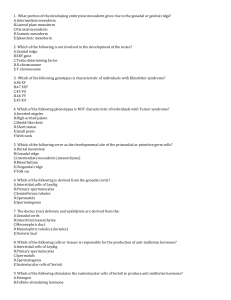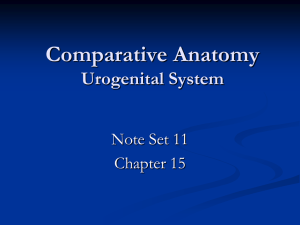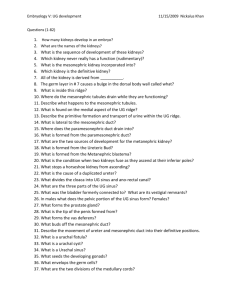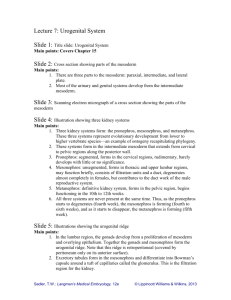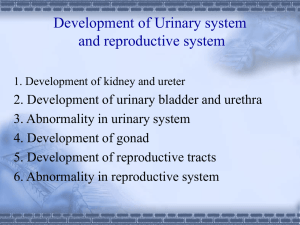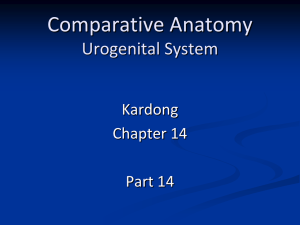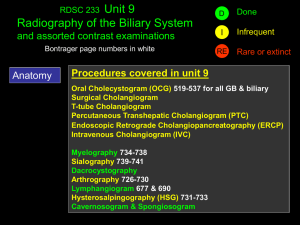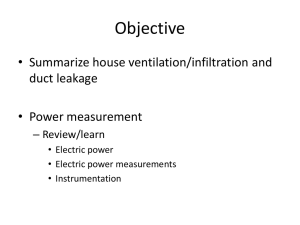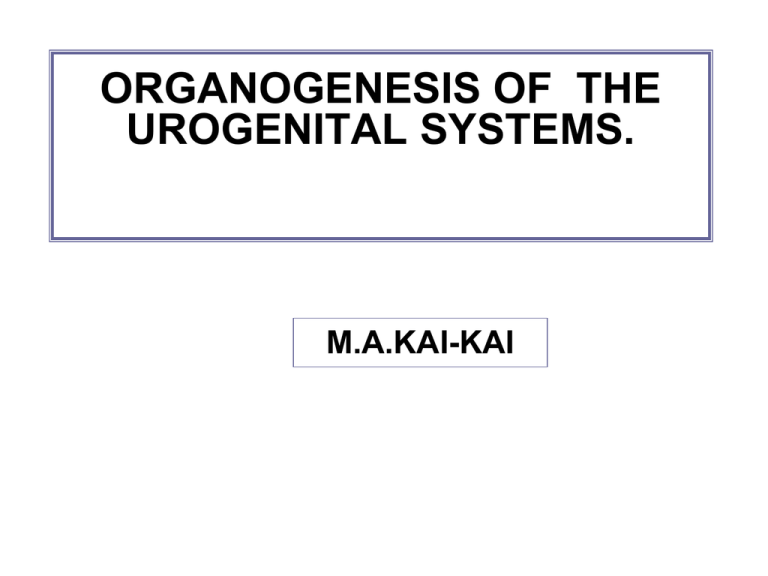
ORGANOGENESIS OF THE
UROGENITAL SYSTEMS.
M.A.KAI-KAI
Learning Objectives
This lecture will discuss:
The derivatives of the intermediate mesoderm
Incuding;
the formation of the nephric systems
the formation of the genital ducts
the formation of the gonads
the formation of the external urinary and genital
organs
Overview of organogenesis of the urogenital organs
Cr.
Urinary and reproductive systems
are closely associated in
D
V
topography,function and
Ca.
development.
Two systems have common origin
from the urogenital ridge(UGR) and
have homologous structures.
Internal genital duct system is
derived from the foetal urinary system.
Malformation of one system affects
Mesonephros
Gonad
(nephrogenic
the other.
Plate)
The UGR is longitudinal swelling in (genital ridge)
dorsolateral side of the abdomen
UGR--> formed mostly from
Mesonephric
--non-segmented intermediate mesoderm
Duct
Lateral UGR(nephrogenic plate)
Paramesonephric
forms urinary organs and internal
duct
genital ducts.
Ventromedial UGR is genital ridge,
The Urogenital ridge
forms gonads.
The nephrogenic plate differentiates in a rostral to
caudal direction and bilaterally. The three nephric
systems appear in recapitulating sequence during
development.
Vestigial
Pronephros
(functional in lower fishes)
Developing
Gastrointestinal
tract
Mesonephric
Tubules(higher fishes and
Amphibians)
Segmented
intermediate
mesoderm
(mesonephros)
Mesonephric
duct
Ureteric
bud
Progression
in time
Unsegmented
intermediate
mesoderm
(mesonephros)
Unsegmented
intermediate
mesoderm
Reptiles,birds,mammals (metanephros)
Sequence of development of the metanephros(1)
Metanephros develops at
somites 26-28 from 2 precursors
--> ureteric bud(UB)
and metanephrogenic mass
[A,(MM)]
Formation UB and MM is by
reciprocal inductive interactions
between the tissues.
The diverticulum forms caudal of
the existing mesonephric duct and
grows and into the MM at the
nephrogenic plate
UB forms the duct system
MM forms nephrons
The ureteric bud branches as it
grows towards the metanephrogenic
mass(B)
Mesonephric duct
Metanephrogenic
mass
A
Urachus
Bladder
Int.mesoderm
Ureteric bud
Collecting ducts
Cr
D
Ca.
Metanephros
Ureter
B
Morphogenesis of the ureteric bud(2)
The ureteric bud forms the duct system
The metanephrogenic mass forms the
nephrons by nephrogenesis.
Nephrogenesis and differentiation of
the ureteric bud are co-ordinated
Dichotomous branching pattern of the
ureteric bud is species specific.
Branching of simple unilobar/
unipyramidal kidneys(dog,horse) the
proximal end dilates into a renal pelvis with
collecting ducts at the tip
In multipyramidal kidneys(ox) ureter
bifurcates into 2 major calyces and several
minor calyces then collecting ducts
Kidney of dog
cortex medulla
renal pelvis
ureter
collecting
duct
collecting duct
cortex
minor calyx
ureter
medulla
major calyx
Kidney of ox
Development of the metanephros(3)
Stages in nephrogenesis.
Solid cluster of metanephrogenic mass forms(A) and
hollows into a renal vesicle(B) with epithelial lining this
elongates into metanephric tubules (C).
Proliferation,elongation of the MM dependent upon
reciprocal tissue interactions using several molecular
signalstubules grow and form parts of nephrons.
Collecting
duct
Fusion
Distal
Ureteric bud by
Nephrogenesis. Formation of glomerulus
Proximal tube forms PCT, end
dilates and invaginates to form the
Bowman's capsule(D)
Distal tube forms DCT and fuses
with the collecting tubule.
BC invaded by the
glomerulusforms renal corpuscle
(RC).
Large numbers of nephrons form
Interstitial connective tissue
forms between nephrons and thick
fibrous capsule surrounds the
kidney.
Nephrogenesis ceases at birth,
continues for 1-3 wks in the dog
and pig
Fusion, elongation of nephric tubules and
association with capillary, to form of
glomerulus
Arteriole
Bowman’s capsule
Collecting tubule
Capillary
Proximal tubule of nephron
Fusion
Collecting
duct
Distal tubule of nephron
Arteriole
Endothelial
layer
Fused basal lamina
Glomerulus
Podocyte layer
Structure of renal
corpuscle (Bowman’s
capsule and glomerulus
Glial derived neurotrophic factor(GDNF) regulates
growth and branching of ureteric bud
A. Wild type mouse has normal
branching of ureteric bud
B. GDNF gene knock out mouse
no branching
Gonadogenesis(1). The bipotential gonad
Gonadogenesis occurs at the genital ridge initiated by 2 simultaneous
events:(i).Formation of gonadal cords
Epithelium from degenerate mesonephric nephrons invade genital
ridge.And form network of epithelial cords
(ii).Migration of primordial germ cells.
PGC are endodermal cells, migrate from the yolk sac into the bipotential
gonad.The gonad has a central medulla and a peripheral cortex,
surrounded by coelomic epithelium.
PGC arrive at the genital
ridge at 21 days cat and
proliferate.
Epithelial incorporate
PGC, forming gonadal
cords.
Gonadal differentiation
begins.
Mesonephric/Wolffian
Dorsal aorta
duct
Glomerulus Arteriole
Mesonephric
tubule
Dorsal
Genital mesentery
ridge
Migratiing
PGC
SEX DETERMINATION
Mullerian/
Paramesonephric
duct
Red arrows shows gene regulation
DAX
Wnt 4
Gonadal ridge
Ovary
Oestrogen
Female genital
ducts
Bipotential
gonad
SRY
Primary sex determination at fertilisation
(i). genetic sex: XY, XX
(ii).Y chromosomes encodes testisdetermining
factorSRYgonadogenesis
secretion of foetal hormones by
interstitial cells[(Sertoli and
Leydig(M),theca cells(F)] secondary
sex(phenotypic sex)
Testis
Anti-Mullerian hormone
(Sertoli cells)
Regression of Mullerian
duct
Testosterone
(Leydig cells)
•Differentiation of Wolffian duct into
Male genital ducts
•Descent of testis
Wolffian duct
Definitive gonads:Testis
Rete testis
A
Dorsal
mesentery
Germ cells and Sertoli cells
Testicular
concentrate in the testicular cords Mullerian duct
cords
Fibrous capsule
The cortex develops a thick fibrous Interstitium
Efferent ducts
capsule
Testicular cords form loops
(seminiferous tubules) and interconnect
with mesonephric tubules to form
efferent ducts
Wolffian duct
B
Mullerian duct
Gilbert 2006
Seminiferous
tubules
Ovary formation.
In the absence of the Y
chromosome in primordial
germ cells.
Ovarian cords
concentrate in the cortex
The medulla
degenerates. The remnants
form the vascular,
lymphatic and nervous
tissues.
Meiosis begins and is
arrested at diplotene of
prophase I when epithelia
surround germ cells
forming primordial follicles.
Wolffian duct
A
Dorsal
mesentery
Interstitium
Mullerian duct
Ovarian cords
Germinal epithelium
B
Wolffian duct
Oocyte
Primordial
follicle
Gilbert 2006)
Formation of the urogenital sinus(UGS)
Cloaca is common opening
for the urinary and digestive
systems and bounded caudally
by the the cloacal membrane.
Formation of the UGS
begins with division of the
cloaca by the mesodermal
urorectal septum separating
cloaca into dorsal anus and
ventral urogenital parts,
bounded by anal and urogenital
membranes.
Membranes degenerate
forming the anal and urogenital
orifice
Schematic diagram of lateral view.15days dog
Mesonephric
A
duct
Metanephrogenic
Mesonephros
mass
Ureteric bud
Hindgut
Hindgut
Urogenital
sinus
Anus
Cr
Cloaca
Urachus
Urorectal
septum
V
D
Ca.
Differentiation of female and male ducts
Mesonephric/
Paramesonephric/
The UGS opens into the
A
Wolffian duct
Mullerian duct
allantoic cavity via the urachus
Hindgut
It divides into a cranial pelvic Bipotential
gonad
Ureter
region and caudal phallic region.
Cloaca
Urachus
--The cranial UGS expands into
Urogenital sinus
the bladder and urethra in both Indifferent Bladder
B
Uterine tube
sexes.
Uterine horns
Rectum
--The caudal UGS forms penile
Anus
urethra in male and vagina in
Ovary
Vagina
Vagina
female.
opening
&
orifice
Uterus
In female(B)Paramesonephric
ducts form female genital ducts, Female Bladder
ureter
fuse caudally to form uterus and Efferent ducts
C
Epididymis
vagina
Ductus deferens Rectum
Undescended
In male(C) the
Anus
testis
Wolffian/mesonephric ducts form
Prostate gland
Ureter
epididymis and ductus deferens.
Bladder
Descended
Testis in
And Mullerian/paramesonephric
Penis
scrotum
Male
duct regresses.
Congenital Malformations.
RENAL
Renal agenesislack of development.
Dysplasiaabnormal development of nephrons and collecting ducts, form
cysts
Hypoplasiaagenesis of ureterhydronephrosis.
Ectopic kidneys and ureters.
Polycystic kidneysfailure of nephrons to join collecting ducts?
REPRODUCTIVE SYSTEM
Rectovaginal constriction at rectovaginal junctionhereditary
Outpockecting of bladder when urachus fails to close.
Cryptorchidismfailure of normal descent of testis.
Mesonephric or paramesonephric duct abnormalitiesstenotic/aplasia of
duct.
Pseudohermaphroditegonads of one sex and external gentalia of the
opposite sex, hormonal factors.
True hermaphrodites is chromosomal abnormality during meiosis when the Y
chromosome gets a fragment of the X chromosome, the gonad or ovo-testes
gonad formed has both ovarian and testicular tissue. And hormones of both
sexes are produced resulting in abnormal external genitalia.
Freemartin cattle intersexuality, a genotypic female(XX) born with normal
male co-twin due to fused placental vessels resulting in the transport of foetal
androgens to the female.
Summary
The urinary system and genital system are derived from the intermediate
mesoderm,the nephrogenic plate and genital ridge of the urogenital ridge.
Three kidneys develops in rapid successionpronephros, mesonephros
and metanephros in cranial-caudal direction.
Pronephros is of limited function in mammals is inducer mesonephros.
The metanephros forms from two precursorsthe ureteric bud and the
metanephrogenic mass.Development of the metanephros requires
reciprocal tissue interaction using several molecular signals.
Sex determination is dependent upon interaction of several
factorsGenetic sex, gonadal sex, hormonal action and phenotypic sex.
Germ cells are endodermal, the other tissues are mesodermal. Early in
development, germ cells migrate from the yolk sac to the genital ridge.
Development of the urogenital system is dependent on molecular signals.
The external urinary and genital organs are formed from the cloaca and
urogenital sinus.
The Wolffian and Mullerian ducts form the adult male and female ducts
respectively.
References
1. Gilbert, Scott.F(2003). Developmental Biology. 6th.Edition.
pp447-461, 523-540, 548-561, Sinauer Associate. Massachusetts.
2. McGeady, T.A., Quinn, P.J., Fitzpatrick, E.S., & Rayan, M.T., (2006).
Veterinary Embryology. Page 233-241; 244-265
3. Noden, M. and de Lahunta(1985). The Embryology of Domestic
Animals, pp 312-341, 349-355 Williams and Wilkins, London.

